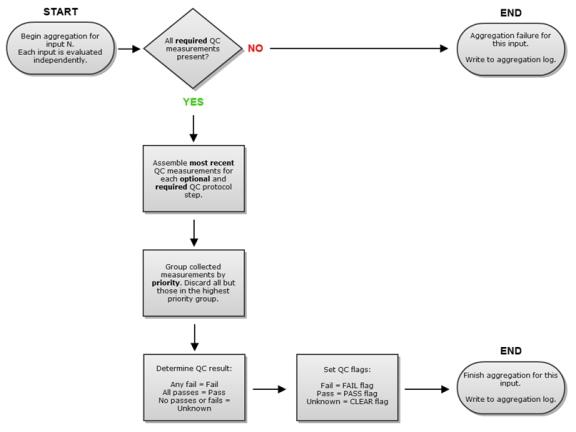Configure Master Step Fields for QC Aggregation
In the default BaseSpace Clarity LIMS configuration, the Aggregate QC step aggregates the results of all QC steps in the protocol—if they are available.
If a step has been removed from a QC protocol, it is ignored and aggregation still occurs for the remaining steps. No error is generated.
The following flowchart shows the logic behind the default configuration of QC aggregation.

Often, this default configuration is acceptable and there is no need to make any changes. However, you can configure alternate QC master step field values that overwrite these defaults. For example, you may want to:
| • | Make a particular step required for aggregation. |
| • | Increase the priority of the results of a particular step—a step whose results are considered more accurate, for example. |
| • | Make one/both of the changes listed, and then lock down values so that users cannot modify them. |
The Aggregate QC master step includes a master step field for each QC step to be considered for aggregation.
The value for the QC master step field may be one of two values:
| • | Use if available—If the QC step was run for a sample, its value is used in the aggregation calculation. If the QC step was not run, it is ignored. |
| • | Required—The step is required for aggregation. If it has not been run for a sample, the QC value cannot be calculated and aggregation does not proceed. |
The default setting for all QC steps is Use if available.
The Required and Use if available master step field values can have an additional (Priority n) suffix.
To be an acceptable value, the value for 'n' may be any value between 1–99, where 1 is the highest priority and 99 is the lowest priority. Master step fields without a priority value defined are assigned a priority of 99.
The default priority value for all QC steps is (Priority 5).
If sample measurements exist for multiple QC steps, all of which have been assigned the same level of priority (as is the case in the default system) the QC flags are evaluated such that any failure results in an overall fail flag for QC aggregation.
Sometimes, however, a particular QC technology may be considered more accurate and you may want its results to take precedence.
For example, a lab may run Bioanalyzer and NanoDrop QC steps on all samples. If one of these steps results in a QC fail, a PicoGreen assay is run on the failed sample and its result is then considered more accurate. In this case, set Bioanalyzer and NanoDrop at priority 5 and PicoGreen at priority 3.
All QC aggregations are logged in an Excel workbook log file and attached to the Aggregate QC step.
Subsequent invocations of the aggregation script results in a new sheet being created in the workbook, in the first sheet position. This new sheet automatically becomes the active sheet.
The best practice method for configuring alternate master step field values for QC aggregation is to create a group of defaults. The fields defined in the group overwrite the default configuration values.
For details, refer to Add and Configure Custom Fields.
The aggregate QC script treats any custom field that does not begin with 'Copy' as a priority master step field. Therefore, you are restricted from adding fields that are not priority fields. Any new priority fields must contain default values of Required and Use if available.
If you do not want lab scientists to be able to manually edit a master step field value, lock it down by setting the Custom Entries toggle switch to No. At run time, the lab scientist must select a value from the predefined drop-down list.
